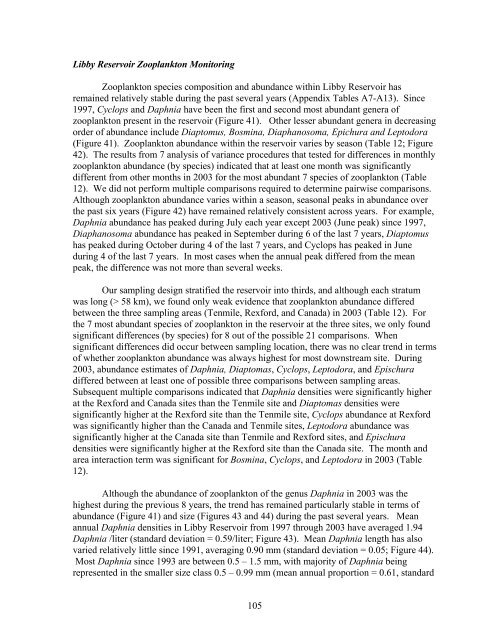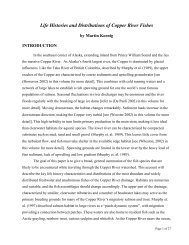Mitigation for the Construction and Operation of Libby Dam
Mitigation for the Construction and Operation of Libby Dam
Mitigation for the Construction and Operation of Libby Dam
You also want an ePaper? Increase the reach of your titles
YUMPU automatically turns print PDFs into web optimized ePapers that Google loves.
<strong>Libby</strong> Reservoir Zooplankton Monitoring<br />
Zooplankton species composition <strong>and</strong> abundance within <strong>Libby</strong> Reservoir has<br />
remained relatively stable during <strong>the</strong> past several years (Appendix Tables A7-A13). Since<br />
1997, Cyclops <strong>and</strong> Daphnia have been <strong>the</strong> first <strong>and</strong> second most abundant genera <strong>of</strong><br />
zooplankton present in <strong>the</strong> reservoir (Figure 41). O<strong>the</strong>r lesser abundant genera in decreasing<br />
order <strong>of</strong> abundance include Diaptomus, Bosmina, Diaphanosoma, Epichura <strong>and</strong> Leptodora<br />
(Figure 41). Zooplankton abundance within <strong>the</strong> reservoir varies by season (Table 12; Figure<br />
42). The results from 7 analysis <strong>of</strong> variance procedures that tested <strong>for</strong> differences in monthly<br />
zooplankton abundance (by species) indicated that at least one month was significantly<br />
different from o<strong>the</strong>r months in 2003 <strong>for</strong> <strong>the</strong> most abundant 7 species <strong>of</strong> zooplankton (Table<br />
12). We did not per<strong>for</strong>m multiple comparisons required to determine pairwise comparisons.<br />
Although zooplankton abundance varies within a season, seasonal peaks in abundance over<br />
<strong>the</strong> past six years (Figure 42) have remained relatively consistent across years. For example,<br />
Daphnia abundance has peaked during July each year except 2003 (June peak) since 1997,<br />
Diaphanosoma abundance has peaked in September during 6 <strong>of</strong> <strong>the</strong> last 7 years, Diaptomus<br />
has peaked during October during 4 <strong>of</strong> <strong>the</strong> last 7 years, <strong>and</strong> Cyclops has peaked in June<br />
during 4 <strong>of</strong> <strong>the</strong> last 7 years. In most cases when <strong>the</strong> annual peak differed from <strong>the</strong> mean<br />
peak, <strong>the</strong> difference was not more than several weeks.<br />
Our sampling design stratified <strong>the</strong> reservoir into thirds, <strong>and</strong> although each stratum<br />
was long (> 58 km), we found only weak evidence that zooplankton abundance differed<br />
between <strong>the</strong> three sampling areas (Tenmile, Rex<strong>for</strong>d, <strong>and</strong> Canada) in 2003 (Table 12). For<br />
<strong>the</strong> 7 most abundant species <strong>of</strong> zooplankton in <strong>the</strong> reservoir at <strong>the</strong> three sites, we only found<br />
significant differences (by species) <strong>for</strong> 8 out <strong>of</strong> <strong>the</strong> possible 21 comparisons. When<br />
significant differences did occur between sampling location, <strong>the</strong>re was no clear trend in terms<br />
<strong>of</strong> whe<strong>the</strong>r zooplankton abundance was always highest <strong>for</strong> most downstream site. During<br />
2003, abundance estimates <strong>of</strong> Daphnia, Diaptomas, Cyclops, Leptodora, <strong>and</strong> Epischura<br />
differed between at least one <strong>of</strong> possible three comparisons between sampling areas.<br />
Subsequent multiple comparisons indicated that Daphnia densities were significantly higher<br />
at <strong>the</strong> Rex<strong>for</strong>d <strong>and</strong> Canada sites than <strong>the</strong> Tenmile site <strong>and</strong> Diaptomas densities were<br />
significantly higher at <strong>the</strong> Rex<strong>for</strong>d site than <strong>the</strong> Tenmile site, Cyclops abundance at Rex<strong>for</strong>d<br />
was significantly higher than <strong>the</strong> Canada <strong>and</strong> Tenmile sites, Leptodora abundance was<br />
significantly higher at <strong>the</strong> Canada site than Tenmile <strong>and</strong> Rex<strong>for</strong>d sites, <strong>and</strong> Epischura<br />
densities were significantly higher at <strong>the</strong> Rex<strong>for</strong>d site than <strong>the</strong> Canada site. The month <strong>and</strong><br />
area interaction term was significant <strong>for</strong> Bosmina, Cyclops, <strong>and</strong> Leptodora in 2003 (Table<br />
12).<br />
Although <strong>the</strong> abundance <strong>of</strong> zooplankton <strong>of</strong> <strong>the</strong> genus Daphnia in 2003 was <strong>the</strong><br />
highest during <strong>the</strong> previous 8 years, <strong>the</strong> trend has remained particularly stable in terms <strong>of</strong><br />
abundance (Figure 41) <strong>and</strong> size (Figures 43 <strong>and</strong> 44) during <strong>the</strong> past several years. Mean<br />
annual Daphnia densities in <strong>Libby</strong> Reservoir from 1997 through 2003 have averaged 1.94<br />
Daphnia /liter (st<strong>and</strong>ard deviation = 0.59/liter; Figure 43). Mean Daphnia length has also<br />
varied relatively little since 1991, averaging 0.90 mm (st<strong>and</strong>ard deviation = 0.05; Figure 44).<br />
Most Daphnia since 1993 are between 0.5 – 1.5 mm, with majority <strong>of</strong> Daphnia being<br />
represented in <strong>the</strong> smaller size class 0.5 – 0.99 mm (mean annual proportion = 0.61, st<strong>and</strong>ard<br />
105
















